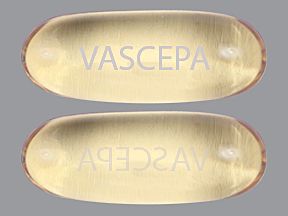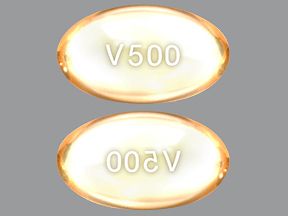If you have high triglyceride levels, your doctor might suggest Vascepa as a treatment option for you. It’s a prescription drug used:
- along with statin medications to lower high triglyceride levels in adults with heart disease or certain heart-related risk factors
- along with diet to lower very high triglyceride levels in certain adults
The active ingredient in Vascepa is icosapent ethyl, which is a type of omega-3 fatty acid. (An active ingredient is what makes a drug work.)
Vascepa comes as a capsule that you swallow. It’s also available as a generic drug.
This article describes the dosage of Vascepa, as well as its strengths and how to take it. To learn more about Vascepa, see this in-depth article.
Note: This article covers Vascepa’s usual dosage, which is provided by the drug’s manufacturer. But when taking Vascepa, always follow the dosage instructions your doctor gives you.
Below is general information on Vascepa’s form, strengths, dosage, and whether it’s taken short or long term.
What is Vascepa’s form?
Vascepa comes as capsules you swallow.
What strengths does Vascepa come in?
Vascepa comes in two strengths: 0.5 gram (g) and 1 g.
What is the recommended dosage of Vascepa?
The information below describes the dosage that is commonly used and recommended. But be sure to take the dosage your doctor prescribes for you. They’ll determine the best dosage to fit your needs.
Dosage for very high triglyceride levels
The daily dose of Vascepa to lower very high triglyceride levels is 4 g per day, taken in divided doses twice per day. The daily dose can be taken as either four 0.5-g capsules twice per day or two 1-g capsules twice per day. You should take Vascepa capsules with food.
Dosage for lowering the risk of heart problems in adults who have high triglyceride levels and certain conditions
The daily dose of Vascepa to lower the risk of heart-related problems in adults with high triglyceride levels is 4 g per day, taken in two divided doses. It can be taken as either four 0.5-g capsules twice per day or two 1-g capsules twice per day. Vascepa capsules should be taken with food.
Is Vascepa used long term?
Yes, Vascepa is usually used as a long-term treatment. If you and your doctor determine that it’s safe and effective for your condition, you’ll likely take it long term.
Below are answers to some common questions about Vascepa’s dosage.
Does Vascepa have a starting dose and a maintenance dose?
No, Vascepa doesn’t have a separate starting and maintenance (continuing) dose. Some medications have a higher starting dose (also known as a loading dose). This is to build up the drug in your body so it can start to work sooner.
But Vascepa only has one recommended dose of 4 grams (g) per day. This is taken in divided doses twice daily with food.
Is Vascepa’s dosage similar to that of fish oil supplements?
Not necessarily. There are many varieties of fish oil supplements sold over the counter. They contain different ingredients and dosages. Your supplement dosage depends on the type of supplement, your age, and other factors, such as any health conditions you may have.
Vascepa is different from fish oil supplements. The active ingredient in Vascepa is a modified version of eicosapentaenoic acid (EPA). Fish oil supplements contain EPA and other omega-3 fatty acids such as docosahexaenoic acid (DHA).
Always talk with your doctor or pharmacist before taking any over-the-counter products, including fish oil supplements. They can discuss the pros and cons of Vascepa versus fish oil supplements and the right dosage for your needs.
You’ll swallow Vascepa capsules twice per day with food. You can take your dose during or just after a meal. You can take either four 0.5-gram (g) capsules twice per day or two 1-g capsules twice per day. Talk with your doctor about the strength of Vascepa that’s right for you.
You should swallow Vascepa capsules whole. Do not crush or chew them. If you have trouble swallowing capsules, see this article for tips, or talk with your pharmacist.
For information on the expiration, storage, and disposal of Vascepa, see this article.
If you miss your regular dose of Vascepa, take it as soon as you remember. But if it’s time for your next dose, don’t double your dose to catch up on the missed dose. This could increase your risk of serious side effects.
If you need help remembering to take your dose of Vascepa on time, try using a medication reminder. This can include setting an alarm or downloading a reminder app on your phone.
Do not take more Vascepa than your doctor prescribes, as this can lead to serious side effects.
What to do in case you take too much Vascepa
Call your doctor right away if you think you’ve taken too much Vascepa. You can also call 800-222-1222 to reach the American Association of Poison Control Centers or use its online resource. But if you have severe symptoms, call 911 (or your local emergency number) immediately or go to the nearest emergency room.
The sections above describe the usual dosage provided by the drug’s manufacturer. If your doctor recommends Vascepa, they’ll prescribe the dosage that’s right for you.
Remember, you should not change your dosage of Vascepa without your doctor’s recommendation. Only take Vascepa exactly as prescribed. Talk with your doctor if you have questions or concerns about your current dosage. Here are some examples of questions you may want to ask them:
- Does my dosage of Vascepa need adjustment if I have kidney problems?
- Would I need a lower dosage of Vascepa if I experience side effects?
- Will my dosage of Vascepa change if the drug isn’t working for me?
For advice on managing your heart health, subscribe to Healthline’s online newsletter.
Disclaimer: Healthline has made every effort to make certain that all information is factually correct, comprehensive, and up to date. However, this article should not be used as a substitute for the knowledge and expertise of a licensed healthcare professional. You should always consult your doctor or another healthcare professional before taking any medication. The drug information contained herein is subject to change and is not intended to cover all possible uses, directions, precautions, warnings, drug interactions, allergic reactions, or adverse effects. The absence of warnings or other information for a given drug does not indicate that the drug or drug combination is safe, effective, or appropriate for all patients or all specific uses.


